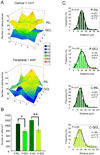beta-Endorphin expression in the mouse retina
- PMID: 20533364
- PMCID: PMC3095846
- DOI: 10.1002/cne.22387
beta-Endorphin expression in the mouse retina
Abstract
Evidence showing expression of endogenous opioids in the mammalian retina is sparse. In the present study we examined a transgenic mouse line expressing an obligate dimerized form of Discosoma red fluorescent protein (DsRed) under the control of the pro-opiomelanocortin promoter and distal upstream regulatory elements to assess whether pro-opiomelanocortin peptide (POMC), and its opioid cleavage product, beta-endorphin, are expressed in the mouse retina. Using double label immunohistochemistry we found that DsRed fluorescence was restricted to a subset of GAD-67-positive cholinergic amacrine cells of both orthotopic and displaced subtypes. About 50% of cholinergic amacrine cells colocalized DsRed and a large fraction of DsRed-expressing amacrine cells was positive for beta-endorphin immunostaining, whereas beta-endorphin-immunoreactive neurons were absent in retinas of POMC null mice. Our findings contribute to a growing body of evidence demonstrating that opioid peptides are an integral component of vertebrate retinas, including those of mammals.
(c) 2010 Wiley-Liss, Inc.
Conflict of interest statement
Authors declare no financial conflict of interest.
Figures










Similar articles
-
The neurons of the ground squirrel retina as revealed by immunostains for calcium binding proteins and neurotransmitters.J Neurocytol. 2002 Sep-Nov;31(8-9):649-66. doi: 10.1023/a:1025791512555. J Neurocytol. 2002. PMID: 14501205
-
Spatiotemporal expression, distribution, and processing of POMC and POMC-derived peptides in murine skin.J Histochem Cytochem. 2000 Jul;48(7):905-14. doi: 10.1177/002215540004800703. J Histochem Cytochem. 2000. PMID: 10858267
-
Prenatal processing of pro-opiomelanocortin in the brain and pituitary of mouse embryos.Brain Res Dev Brain Res. 1991 Jun 21;60(2):179-85. doi: 10.1016/0165-3806(91)90046-l. Brain Res Dev Brain Res. 1991. PMID: 1654230
-
[Corticotrope].Nihon Rinsho. 1993 Oct;51(10):2606-10. Nihon Rinsho. 1993. PMID: 8254928 Review. Japanese.
-
A view of the N-acetylation of alpha-melanocyte-stimulating hormone and beta-endorphin from a phylogenetic perspective.Ann N Y Acad Sci. 1993 May 31;680:161-74. doi: 10.1111/j.1749-6632.1993.tb19682.x. Ann N Y Acad Sci. 1993. PMID: 8390150 Review. No abstract available.
Cited by
-
DLK1 is a somato-dendritic protein expressed in hypothalamic arginine-vasopressin and oxytocin neurons.PLoS One. 2012;7(4):e36134. doi: 10.1371/journal.pone.0036134. Epub 2012 Apr 26. PLoS One. 2012. PMID: 22563444 Free PMC article.
-
Dopaminergic amacrine cells express opioid receptors in the mouse retina.Vis Neurosci. 2012 May;29(3):203-9. doi: 10.1017/S0952523812000156. Vis Neurosci. 2012. PMID: 22643230 Free PMC article.
-
Light-evoked S-nitrosylation in the retina.J Comp Neurol. 2015 Oct 1;523(14):2082-110. doi: 10.1002/cne.23780. Epub 2015 May 12. J Comp Neurol. 2015. PMID: 25823749 Free PMC article.
-
Characterization of multiple bistratified retinal ganglion cells in a purkinje cell protein 2-Cre transgenic mouse line.J Comp Neurol. 2013 Jun 15;521(9):2165-80. doi: 10.1002/cne.23279. J Comp Neurol. 2013. PMID: 23224947 Free PMC article.
-
The Neuropeptide Systems and their Potential Role in the Treatment of Mammalian Retinal Ischemia: A Developing Story.Curr Neuropharmacol. 2013 Jan;11(1):95-101. doi: 10.2174/157015913804999423. Curr Neuropharmacol. 2013. PMID: 23814541 Free PMC article.
References
-
- Andrade da Costa BL, Hokoc JN. Coexistence of GAD-65 and GAD-67 with tyrosine hydroxylase and nitric oxide synthase in amacrine and interplexiform cells of the primate, Cebus apella. Vis Neurosci. 2003;20(2):153–163. - PubMed
-
- Bicknell AB. The tissue-specific processing of pro-opiomelanocortin. J Neuroendocrinol. 2008;20(6):692–699. - PubMed
-
- Borbe HO, Wollert U, Muller WE. Stereospecific [3H]naloxone binding associated with opiate receptors in bovine retina. Exp Eye Res. 1982;34(4):539–544. - PubMed
-
- Brecha NC. Peptide and peptide receptor expression and function in the vertebrate retina. In: Chalupa, Werner, editors. The visual neurosciences. Cambridge, Massatchusetts: The MIT Press; 2003. pp. 334–354.
Publication types
MeSH terms
Substances
Grants and funding
LinkOut - more resources
Full Text Sources
Molecular Biology Databases
Miscellaneous

